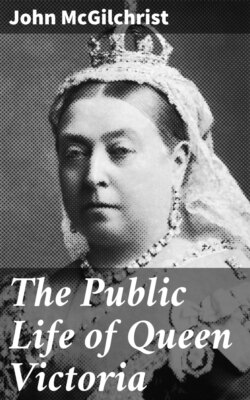Читать книгу The Public Life of Queen Victoria - John McGilchrist - Страница 5
На сайте Литреса книга снята с продажи.
CHAPTER III.
ОглавлениеTable of Contents
PARENTAGE AND BIRTH OF QUEEN VICTORIA.
How the Princess Victoria came to be Heiress Presumptive to the Throne—Death of the Princess Charlotte—Marriages of the Royal Dukes—Of the Duke of Kent—Birth of the Princess Alexandrina Victoria—Prediction of George IV.—Death of the Duke of Kent—His Character—His Liberal Opinions—Public Condolence with the Widow and Orphan—Early Life of the Duchess of Kent.
MARRIAGE OF THE DUKE OF KENT.
On the 6th of November, 1817, the hopes of the nation, which had so fondly rested upon the happy union between the Princess Charlotte and Prince Leopold, were fatally blasted by Her Royal Highness’s death, shortly after her delivery of a still-born child. Never in our history was a blow felt more deeply and personally by all the nation, than this bereavement. The death of the Princess Charlotte severely and most painfully disappointed the nation in its general expectation with regard to the much desired succession to the throne in the person of herself and her heirs. The Duke of Cumberland, who was hated by all, was the only married younger son of the king, and there was a general desire that the other royal princes, especially the popular and estimable Dukes of Kent and Sussex, should seek out suitable partners. The Duke of Kent rightly felt that the House of Brunswick was dear to the English people, that the nation had a very strong desire that the question of succession should be placed beyond doubt, and that, considering the uncertainty of the chances of life, and of leaving offspring, it was clearly his duty to marry. Indeed, he had already, ere the untimely death of his niece, offered his hand and heart to the widowed Princess of Leiningen. The Princess Charlotte tenderly loved her uncle Kent, who had done so much to promote the attainment of the wishes of her own heart, and she did all she could to promote the marriage of her uncle with the sister of her husband. But the position of the Princess of Leiningen as guardian of her two children occasioned delays; and no unimportant matter was the fact that if she re-married, she would sacrifice a jointure of nearly £5,000 a year, while the Duke of Kent was punished by the Court for his free and outspoken Liberal opinions by being restricted to a very meagre pecuniary allowance from the Tory Parliament. At last, however, all minor difficulties were smoothed over. On the 13th of May, a message was brought down to Parliament, announcing that “the Prince Regent had given his consent to a marriage between the Duke of Kent and Her Serene Highness Mary Louisa Victoria, daughter of the Duke of Saxe-Coburg-Saalfeld, widow of Enrich Charles, Prince of Leiningen, and sister of Prince Leopold.” Of all the royal marriages, this was the one which the heart of the country went most thoroughly along with. The Duke of Kent never disguised—indeed, he openly proclaimed—his attachment to the principles of the popular party; and the fact of the close relationship of his intended wife to Prince Leopold was another strong recommendation. The marriage was celebrated, first according to the Lutheran rites in Germany, on the 29th May, 1818, and, on the 13th of July following, by the Archbishop of Canterbury; the Prince Regent, on the latter occasion, giving away the bride. In the same summer, the Dukes of Clarence and Cambridge had married. The Duke of Sussex, whose affections and sympathies were otherwise engaged, declined to contract a foreign alliance; but he took the liveliest interest in the marriage of his favourite brother Kent, as he also did in the future welfare and prosperity of his niece.
